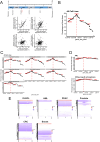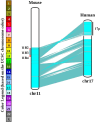Deletion of 17p in cancers: Guilt by (p53) association
- PMID: 39966556
- PMCID: PMC11876076
- DOI: 10.1038/s41388-025-03300-8
Deletion of 17p in cancers: Guilt by (p53) association
Abstract
Monoallelic deletion of the short arm of chromosome 17 (del17p) is a recurrent abnormality in cancers with poor outcomes. Best studied in relation to haematological malignancies, associated functional outcomes are attributed mainly to loss and/or dysfunction of TP53, which is located at 17p13.1, but the wider impact of deletion of other genes located on 17p is poorly understood. 17p is one of the most gene-dense regions of the genome and includes tumour suppressor genes additional to TP53, genes essential for cell survival and proliferation, as well as small and long non-coding RNAs. In this review we utilise a data-driven approach to demarcate the extent of 17p deletion in multiple cancers and identify a common loss-of-function gene signature. We discuss how the resultant loss of heterozygosity (LOH) and haploinsufficiency may influence cell behaviour but also identify vulnerabilities that can potentially be exploited therapeutically. Finally, we highlight how emerging animal and isogenic cell line models of del17p can provide critical biological insights for cancer cell behaviour.
© 2025. The Author(s).
Conflict of interest statement
Competing interests: The authors declare no competing interests financial or otherwise Preparation of this article was supported by a Northwest Cancer Research UK and Bloom Appeal (NWCRTBA2021.02) grant funding to AC, MG, ARP, NK and JRS.
Figures







References
-
- Ben-David U, Amon A. Context is everything: aneuploidy in cancer. Nat Rev Genet. 2020;21:44–62. - PubMed
Publication types
MeSH terms
Substances
Supplementary concepts
LinkOut - more resources
Full Text Sources
Medical
Research Materials
Miscellaneous

